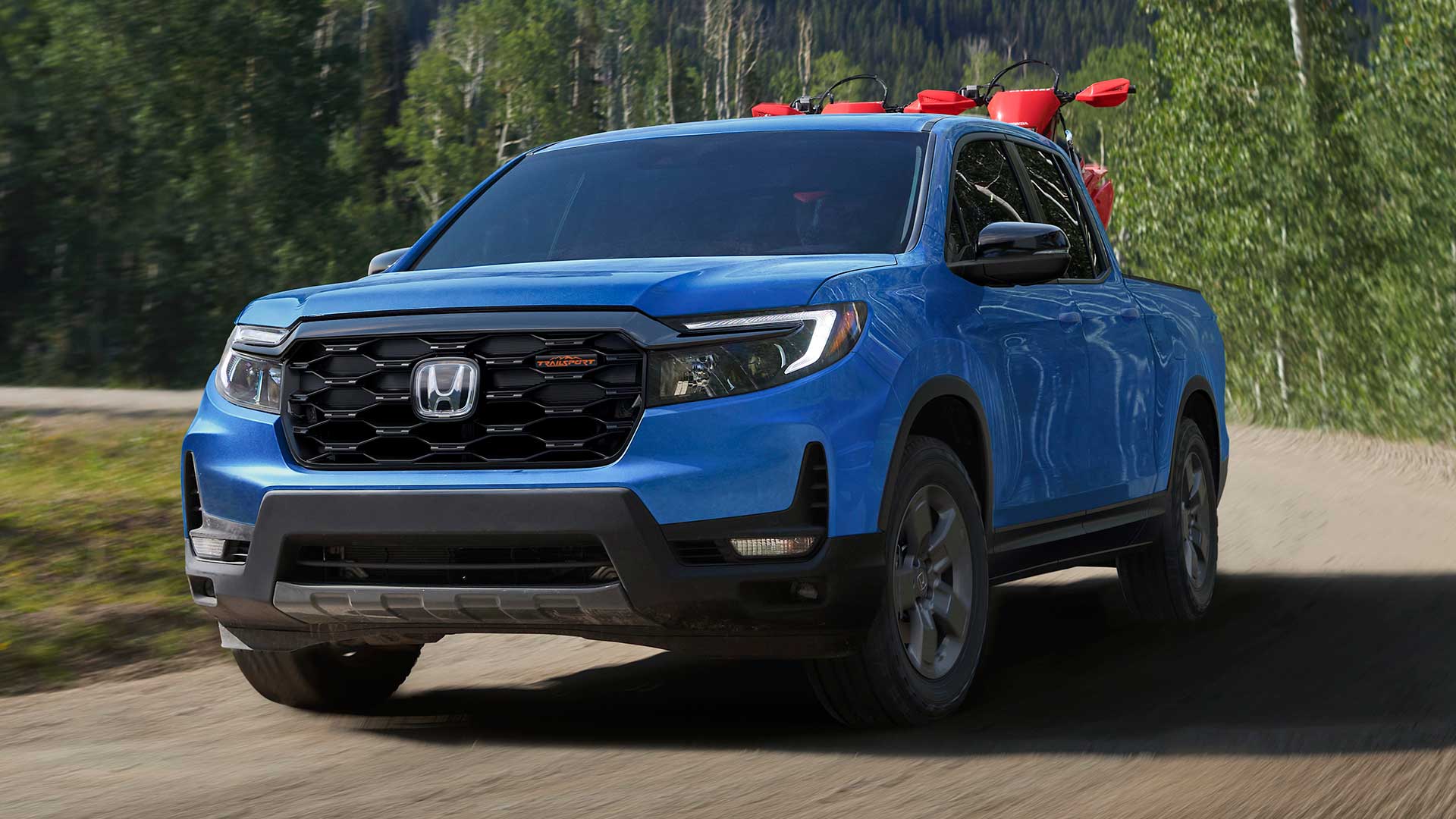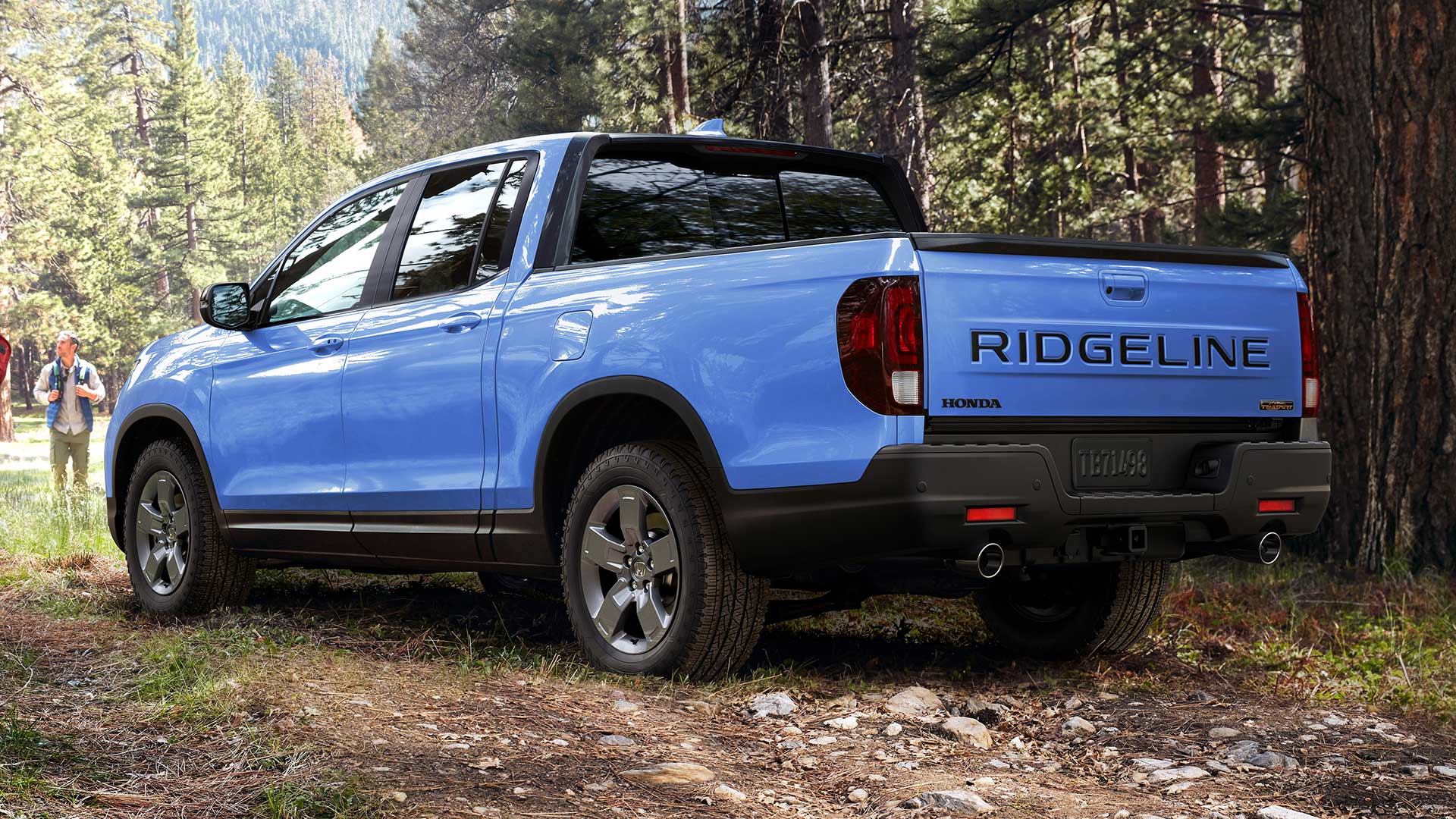2010 Cadillac SRX
With all the success Cadillac has had in transforming itself into a world-class rival to European and Asian luxury marques, one notable exception has been the SRX Crossover utility. Now the first gen 2004 SRX just never caught the attention of upper income households. Now, SRX has been totally rethought. And the result is a smaller, sharper, more standout design. So let’s see if the second time is a charm.
The new generation 2010 Cadillac SRX luxury crossover utility cuts a significantly different swath than the original. For one thing, it’s smaller, losing a little more than five inches in wheelbase, and a little less than five inches in length. That makes the new SRX much closer to its targeted rival, the Lexus RX.
But, thanks to Cadillac’s edgy styling, the new SRX comes off bolder and more muscular than the Lexus. Up front is a shield grille, flanked by Cadillac’s signature vertical headlamps with available adaptive swivel lighting.
The SRX’s profile is dynamic, accentuated by short windows, side vents, and a fast-moving upward-swept accent line.
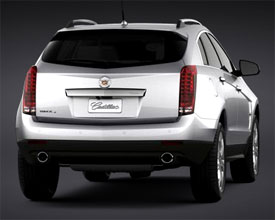 Out back, the raring-to-go look is extended by a roof spoiler and dual chrome exhaust tips.
Out back, the raring-to-go look is extended by a roof spoiler and dual chrome exhaust tips.
Wheels are pushed to the corners, in either 18-inch or 20-inch.
Something else that has changed on the new SRX is cabin capacity. From seven it has dropped to five, again the same as the Lexus RX. But what a cabin they will ride in. The SRX interior styling mixes elegance with energy, with a hand-crafted look and fit and finish that is the best ever from a domestic brand.
Gauges and controls are displayed in a logical yet sophisticated manner. The wide center stack is home to an available 3D navigation system that rises from the top of the panel.
Other goodies include an available back-up camera, a Bose 10-speaker stereo system, and an integrated hard disk drive for audio storage.
Seats are fitted with soft leather. They are plush and very supportive with standard 8-way power for the driver and optional heat.
There is ambient lighting by night, and—if you choose—sunlight by day through Cadillac’s latest panoramic sunroof.
The rear seating area is ample space for three adults, with a welcomed two extra inches of legroom over its Lexus rival. The split bench has a center armrest and it also reclines, though the control is hard to reach.
The angled rear of the SRX cuts cargo room compared to its rival. Still, 29 cubic feet seats up, and 61 cubic feet seats down is within class specs. Plus, a flexible “U-rail” adjustable tie-down system and under-floor storage make it very versatile—all reached by an adjustable height power tailgate that is standard on all but the base model.
Under the hood, more big changes for the SRX. The previous V6 and V8 powertrains have been replaced by smaller more efficient designs. Standard is a new direct-injected 3.0-liter V6 with 265 horsepower and 223 pound-feet of torque. Optional is a 2.8-liter turbocharged V6, good for 300 horses and 296 pound-feet of torque.
Each ties to a 6-speed automatic with manual mode. The turbo adds an “eco mode” which alters shift points to optimize fuel economy.
While the 3.0 has adequate response for a 4500-pound crossover, our 2.8T tester delivered a strong launch, with a fast power build. Shifts are well-spaced and solid all the way up the ladder. We find a 7.6-second 0 to 60 very respectable.
Power is relegated to the front or to all four wheels through a sophisticated Haldex transfer case that is standard with the 2.8T. For optimal traction and balance, it can transfer up to 100% of torque front to back, and up to 85% side-to-side at the rear.
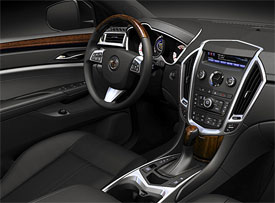 The SRX rides on an all-new chassis that is not shared with other GM crossovers. All-wheel-drive integrates with an available real-time damping system for a high degree of cornering prowess. We found the SRX to be very agile and quick-footed on both city streets and fast country sweepers, feeling more drivers’ car than crossover.
The SRX rides on an all-new chassis that is not shared with other GM crossovers. All-wheel-drive integrates with an available real-time damping system for a high degree of cornering prowess. We found the SRX to be very agile and quick-footed on both city streets and fast country sweepers, feeling more drivers’ car than crossover.
Ditto the brakes, with ABS, vented disc, and two-piston front calipers.
Government Fuel Economy Ratings for the SRX 2.8 Turbo are estimated at a modest 16 city/21 highway on premium gas. We saw only 16.8 miles per gallon in real-world driving.
SRX pricing begins over six grand less than last year, and lower than rival RX. Base is $34,155, with the 2.8T expected to sticker at just under fifty thousand.
The 2010 Cadillac SRX is a huge improvement, and now more clearly targeted towards its luxury-crossover rivals. It has the potential of doing for Cadillac crossovers what the CTS did for their sedans. But, quantum leap or not, it’s now a real charmer.
Specifications
- Engine: 2.8-Liter Turbocharged V6
- Horsepower: 300
- Torque: 296 Lb Feet
- 0-60 MPH: 7.6 Seconds
- EPA: 16 MPG City/ 21 MPG Highway
- Mixed Loop: 16.8 MPG
2024 Honda Ridgeline TrailSport
It Does Truck-Like Things Better Than Ever
Honda brought something truly unique to the pickup truck scene when their mid-size Ridgeline debuted for 2006. In 2017, it moved towards becoming a little more true truck-like, both in form and capability, now with yet another step in that direction for 2024. So, let’s see if the Ridgeline is really hitting its stride.
For 2024, it’s all about making this Honda Ridgeline better than ever. There are styling tweaks outside, along with tech and functional improvements inside, but the biggest news is the Ridgeline has now joined Honda’s TrailSport family of off-road inspired vehicles. This more-true-trucklike, second-gen Ridgeline been around since 2017, receiving periodic updates over the years; but joining the TrailSport family is the biggest leap yet.
Primarily, the TrailSport transformation includes General Grabber all-terrain tires, mounted on new Pewter Gray 18-inch wheels, steel underbody protection, and retuning the strut front, and multi-link rear suspension for added wheel articulation. And while we always appreciate the additional traction of off-road tires, the Ridgeline’s standard i-VTM4 all-wheel drive, with Intelligent Traction Management and snow, sand, and mud settings, was already quite capable of handling all but the most extreme off-roading, ground clearance of just 7.6 inches being it’s only real hinderance.
A 3.5-liter V6 remains under the hood as it has since the Ridgeline debuted for 2006; the current version outputs 280 horsepower and 262 lb-ft of torque, plenty enough muscle to handle its 5,000-lbs. towing capacity. A nine-speed automatic transmission with paddle shifters and bevy of push and pull buttons on the console replaced the six-speed automatic back in 2020.
In addition to adding TrailSport capability, a big focus for this update was making it more user-friendly inside, starting with the central touchscreen growing from 8 to 9 inches. It also gets faster processing speeds, menus have been simplified, and the native navigation system is improved with better graphics. It’s accompanied by a new digital instrument cluster, along with an upgraded center console with more storage space. Unique TrailSport touches include heavy duty floormats, leather-trimmed seats, orange stitching throughout the cabin, and orange ambient lighting.
The Ridgeline continues to offer things available nowhere else in the pickup truck market.
Exterior styling doesn’t exactly shout “macho big rig coming your way,” but the more vertical face and larger grille that arrived for 2021, along with this year’s added TrailSport elements, do continue to toughen up the Ridgeline’s image. The 5’4” bed remains highly functional with no large wheel well intrusions, multiple tie-downs points, lighting and even speakers. And of course, the Ridgeline continues to offer things available nowhere else in the pickup truck market, like the dual-action tailgate, and large, lockable, drainable, underbed storage. Not to mention being able to drive around in true car-like comfort, something we took full advantage of on our way to our Mason Dixon Dragway test track.
There was great grip off the line, with full power arriving smoothly but quickly, helping us to get to 60 in 7.0 seconds flat, a tenth quicker than the last Ridgeline we tested. That power delivery stayed fairly consistent the whole way down the track, barely interrupted by the nine-speed automatic’s smooth shifting. Our best quarter-mile run was 15.5 seconds at 90 mph.
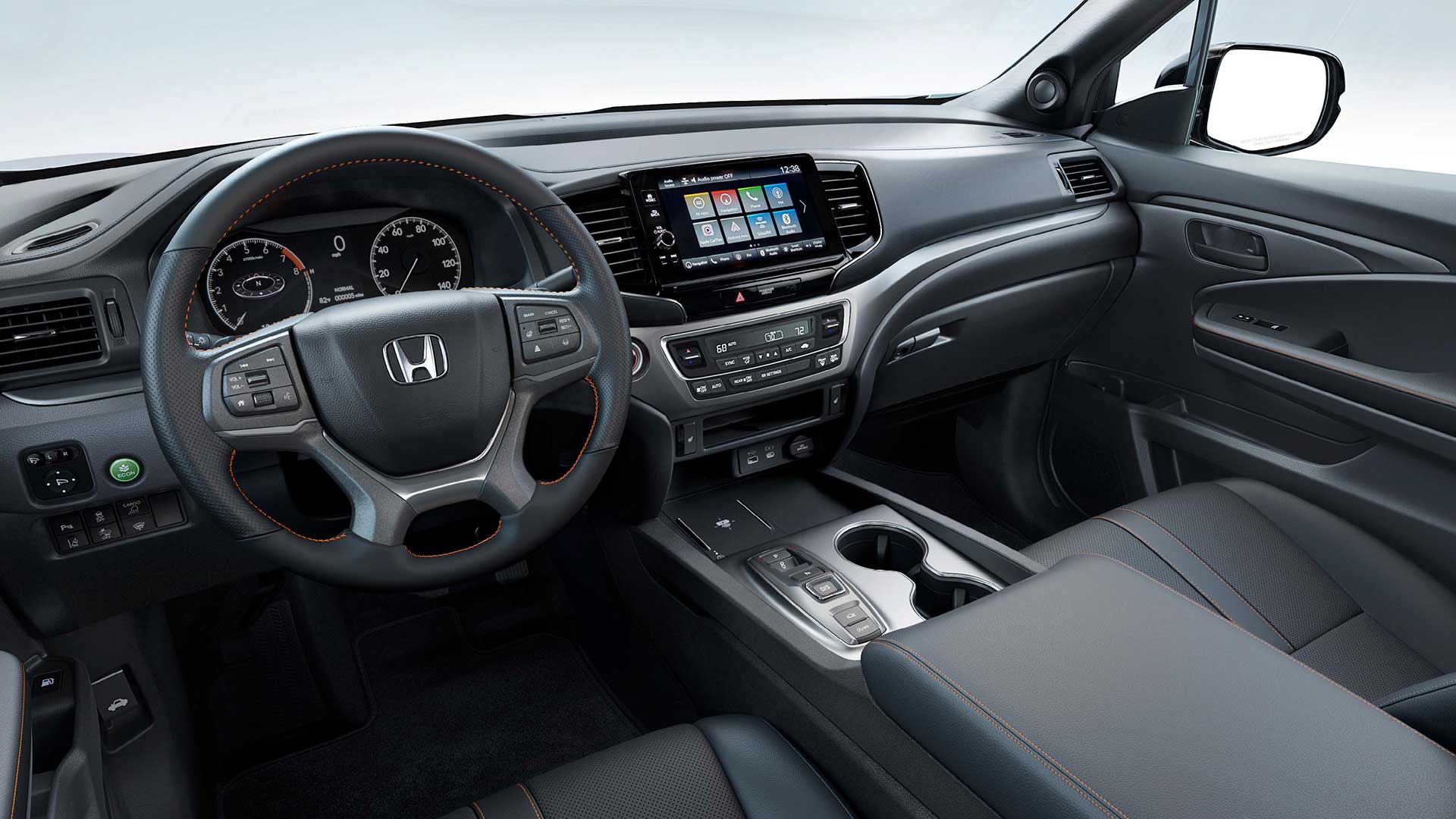
The revised suspension and knobbier tires didn’t really seem to add or detract from handling prowess, as it felt as solid, nimble, and car-like as it always has through our cone course. Perhaps a little less stiff than before, but good feedback, tight steering, and minimal body roll for a pickup, made for a very confidence inspiring experience. In our braking test, we stopped in a respectable average of 123 feet from 60, with only moderate amounts of nosedive and good feel through the pedal.
There is, however, a slight reduction in Government Fuel Economy Ratings with the all-terrain tires; 18-City, 23-Highway, and 20-Combined, our average, right on, at 20.4 mpg of Regular. That’s a slightly below average Energy Impact Score of 14.9 barrels of yearly oil use, with CO2 emissions of 7.4 tons.
TrailSport pricing falls in line just under the Ridgeline’s top Black Edition trim with a starting price of $46,375, about five grand over a base Ridgeline Sport.
So, whether you consider the Honda Ridgeline to be a “real” truck or not, this ruggedly smooth 2024 TrailSport does truck-like things better than ever. And we’re not just talking about the slight upgrade in off-road performance, we’re talking about a flexible bed to help you get chores done, and the ability to tow or haul with comfort and flexibility other trucks can only wish for. It’s why the Ridgeline brings more first-time buyers to Honda than any other vehicle, and why it continues to be a great choice in the growing midsize truck realm.
Specifications
- Engine: 3.5-liter V6
- Transmission: 9-speed automatic
- Horsepower: 280
- Torque: 262 lb-ft
- EPA: 18 City | 23 Highway | 20 Combined
- 0-60 mph: 7.0 seconds
- 1/4 Mile: 15.5 seconds at 90 mph
- 60-0 Braking (avg): 123 feet
- MW Fuel Economy: 20.4 mpg (Regular)
- Max Towing Capacity: 5,000-lbs








